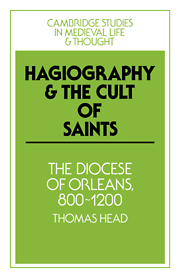Book contents
- Frontmatter
- Contents
- List of figures and maps
- Acknowledgements
- List of abbreviation
- INTRODUCTION
- 1 THE CAROLINGIAN PERIOD
- 2 THE CAPETIAN PERIOD
- 3 THE IDEAL OF SANCTITY: FORMATION, IMITATION, AND DISSEMINATION
- 4 THE POSTHUMOUS PATRONAGE OF THE SAINTS
- 5 SAINTLY PATRONAGE AND EPISCOPAL AUTHORITY AT THE ABBEY OF MICY
- 6 SAINTS, ABBOTS, AND ECCLESIASTICAL POLITICS AT FLEURY AND PITHIVIERS
- CONCLUSION
- Bibliography and references
- Index
5 - SAINTLY PATRONAGE AND EPISCOPAL AUTHORITY AT THE ABBEY OF MICY
Published online by Cambridge University Press: 22 September 2009
- Frontmatter
- Contents
- List of figures and maps
- Acknowledgements
- List of abbreviation
- INTRODUCTION
- 1 THE CAROLINGIAN PERIOD
- 2 THE CAPETIAN PERIOD
- 3 THE IDEAL OF SANCTITY: FORMATION, IMITATION, AND DISSEMINATION
- 4 THE POSTHUMOUS PATRONAGE OF THE SAINTS
- 5 SAINTLY PATRONAGE AND EPISCOPAL AUTHORITY AT THE ABBEY OF MICY
- 6 SAINTS, ABBOTS, AND ECCLESIASTICAL POLITICS AT FLEURY AND PITHIVIERS
- CONCLUSION
- Bibliography and references
- Index
Summary
As the stories of miraculous cures, chastisements, and court cases indicate, the beliefs of the clerics and laity of the Orléanais rendered the patronage provided by the ‘fathers’ of the diocese very powerful indeed. While this sense of the miraculous was crucial to that patronage, the ‘fathers’ did not exercise their power solely in those events deemed to be miracles. As the patrons of abbeys and collegiate churches, the ‘fathers’ also wielded an ongoing lordship over communities of monks and canons. They were important figures in the structures of ecclesiastical authority within the region. The power of the patron saints can be seen in the history of the abbey of Micy, which had a proud legacy from the ‘fathers’ of the Merovingian age. According to tradition it had been founded in the sixth century by Clovis as a gift to two holy men from Verdun, Maximinus and his elderly uncle, Euspicius. The former became not only the first abbot of the new monastery, but a renowned teacher of the contemplative life as well. Sacked and abandoned during the wars of the eighth century, Micy was refounded by Bishop Theodulf of Orléans (c. 790–818). From that time it remained firmly under episcopal control, a power that often worked, in the eyes of the monks, to their detriment. Although the monastery had originally been dedicated to St Stephen, the monks primarily venerated the memory of their first abbot, Maximinus.
- Type
- Chapter
- Information
- Hagiography and the Cult of SaintsThe Diocese of Orléans, 800–1200, pp. 202 - 234Publisher: Cambridge University PressPrint publication year: 1990



